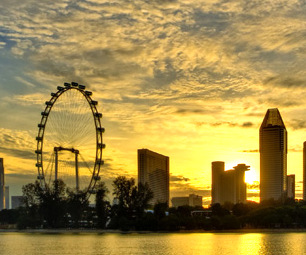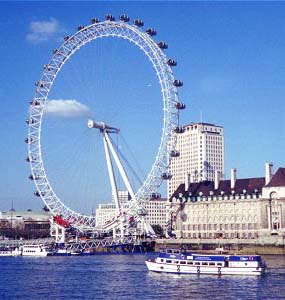This article was recently published on Kyith Ng's blog and is republished with permission. STRACO CORPORATION is a stock that I have owned for some time, one that has taught me some invaluable investment lessons.
STRACO CORPORATION is a stock that I have owned for some time, one that has taught me some invaluable investment lessons.
For some time, the company has updated shareholders that it was looking for projects to deploy its capital to. It has finally found one.
Mainboard-listed Straco Corporation, 63 per cent-owned by the chairman's family, is buying the 165-metre-high Singapore Flyer attraction by the Marina Promenade for S$140 million. Straco will fund the purchase with part of its S$100 million cash pile. The company will also be taking on debt.
Dubbed the highest observation wheel in the world, the Flyer is a prominent feature of the Singapore skyline.
Some details of the deal
The Singapore Flyer have been in the news for some years now, all for the wrong reasons. It did put Singapore on the world map but its owner, Singapore Flyer Pte Limited, went into receivership in May 2013.
Straco basically swooped in on a distressed asset. Merlin Entertainments, listed in London, the second biggest operator of visitor attractions in the world behind only Walt Disney Parks and Resorts, and the operator that runs the London Flyer, Legoland and Madam Tussauds was in contention but subsequently pulled out of it.
|
· |
Wheels cost a lot to build, not so much to maintain
These Ferris wheels, due to their size, cost a bloody lot to build. They cost 100 to 200 mil dollars in 2008 to build. As a reference, the London Eye cost 70 mil pounds to build in 2000. The S$240 mil cost to build the Flyer is equivalent to 90 mil pounds.
They are like large infrastructure which needs to be financed by large amount of debt. Just like toll roads, you need a minimum number of people or cars to generate enough cash flow to repay debt.
What usually kill large projects are unrealistic costs and hidden fees. This is prevalent especially when you deal with bankers, who will keep piling on fees and more fees.
The end result is what you see in a lot of toll roads and public infrastructure: The cash flow generated is insufficient to ever pay off the infrastructure, let alone return a profit.
From the case study of the London Eye, capital expenditure in terms of maintenance does not seem to be an issue. The London Eye's maintenance was 4% of revenue, but that is due to a higher number of visitors. There are some maintenance costs that are likely to be rather fixed.
Since the Flyer's ridership is 50% less than the Eye's, and that there is a floor to cost, we would expect its maintenance cost to be in the region of 7-8% of revenue.
The important task is to keep the number of visitors consistent and growing, and that may need other forms of capex. Straco might need to do what Tussauds Group did, spending big to gem up the Flyer.
Once that is done there are really minimal costs. The wheel is cash flow generating.
| ♦ The London Eye case study |
|
Another theme attraction that is rather similar to The Flyer is the Ferris wheel in London. In fact, the Singapore government seems to be like a big copycat. Built in 2000, the Eye has a 13-year operating history. Merlin Entertainments owns it. News articles provide some information. · In 2001, number of visitors was 3.5 mil. The loss was 8 mil pounds. Revenue was 25 mil pounds. Operating profit was estimated at 6.5 mil pounds. The debt then was 76 mil pounds. Ticket prices then were 4.95 and 7.95.
|
Ticket prices have changed a fair bit but it is interesting to note what such a tourist attraction can grow to. London Eye back in 2009 was a very popular attraction despite the global financial crisis.
The number of visitors more than doubled that of the Flyer, and that perhaps made the difference. The profit margins look good, in part because the attraction has built up the critical mass that makes it a very good cash flow generating machine (the variable revenue over cost factor).
Bond-like nature
The most interesting thing is that the Eye, being the number 1 attraction in London, can attract a consistent 3.5 mil visitors for 13 years. The ticket prices goes up with inflation, cost is a fraction.
Without the debt it's a really good asset.
Difficulty in increasing visitors
The consistent number of visitors seems to tell me that it will take rather extreme levels of innovation to bring up the visitor numbers for Straco's Singapore Flyer. The guys at Tussauds Group and now Merlin cannot be idiots.
If the London Eye has a capacity of 6.4 mil or so, why can’t Merlin boost the number of visitors to 4 mil per year?
Perhaps we should tamper our expectations of how many visitors Straco can attract. The previous operator originally expected 2.5 mil visitors per year in 2008. They hit 1.9 mil and have not reached anywhere close since.
God knows how the target of 2.5 mil visitors came about. I get a feeling it's some estimation done so that bankers can justify the cost of financing.
If the Flyer is truly mismanaged in terms of synergistic opportunities, then let's see if Straco can take it up a little bit.
How revenues are increased
So we know that visitor numbers at the Eye were rather consistent from 2000 to 2013. Revenue grew from 25 mil to 38 mil in 2004 (11% CAGR) to 56 mil in 2009 (10% CAGR).
The ticket prices averaged 6.5 pounds in 2000 and 20 pounds in 2009. That is 13% growth. Most of the earnings perhaps were directly attributable to maintaining visitors and ticket prices growth.
It's interesting how they can grow prices and maintain visitors. That requires skill.
This would mean that Straco need to find opportunities to raise prices. As of now, I don’t think it's possible. Instead, it would probably have to offer discounts.
Different Heritage and Identity
The London Eye was not without its critics in the early stage:
However, despite some people being more than enthusiastic about the date rolling over from 1999 to 2000, some others were having a bout of pre-millennial cynicism. Did London really need a new structure among its sprawling urban wasteland and defunct dockyards? Did anyone really care enough about the Millennium to want to go to yet another tourist attraction in the Capital? And more importantly, were the ideas just too ‘modern’ for the judges to cope with? – Link
In many things, the initial phase will usually be met with doubts. The London Eye was no exception but they do have an old Ferris wheel so this looks like a revamp of that.
Singaporeans seem to identify the Flyer more with the incumbent government hell bent on creating some levels of national identity and some feel rather repelled by this.
This does present an opportunity because identity is not forged through physical construction but by stories that it is associated with. And it is up to the Singapore Tourism Board as well as the owners to create meaningful stories tied to the Flyer. People can then become proud of it, see it as something they really own, and tourists would want to come and find out why they are so proud of it.
Part 2: Kyith Ng: "Ways To Boost Profit Of Singapore Flyer"




